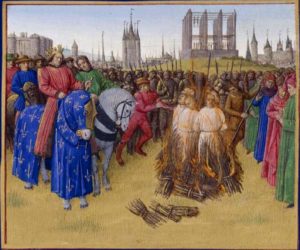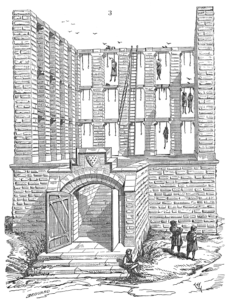
The next time you’re in Paris, stop by 53, rue de la Grange aux Belles (10e). You’ll be standing in front of a garage with apartments built on top—sounds exciting, huh? Seven hundred or so years ago, this was a pretty scary site. You never wanted to end up here.
You are standing in an area that was once part of the countryside outside the medieval walls of Paris. Standing here, you would have had a pretty good view of the city. You’re on a hill (actually, more like a mound). The area we now call Montmartre would have been visible to you toward the northwest. Surrounding you would have been the leper colony of St. Lazare, the Convent of the Filles-Dieu (a home for prostitutes), and the original Hôpital Saint-Louis. Clearly, the king did not want any undesirable elements with the walls of his city.
Hanging Around

One of the monarch’s most undesirable icons stood in front of you. It was the Gibet de Montfaucon (Gibbet/Gallows of Montfaucon). Erected around the late 13th century, the gibbet was used until 1629 and finally dismantled in 1760. The structure was used to hang people and to display the bodies of the executed (both local and imported). There are written accounts of the executed being displayed here for more than three years before they were either posthumously exonerated or whatever remained of the body was turned over to the family. Read More Hanging Around Medieval Paris

